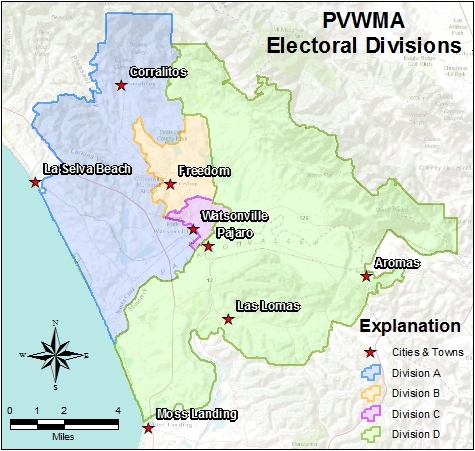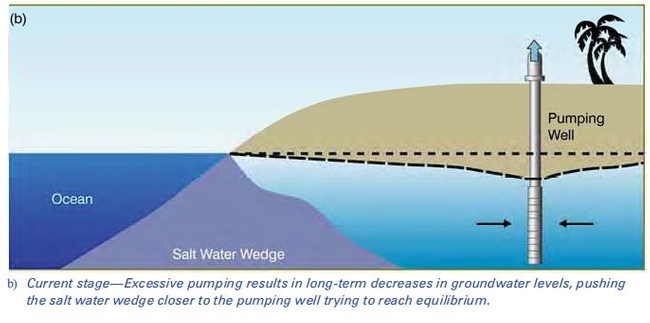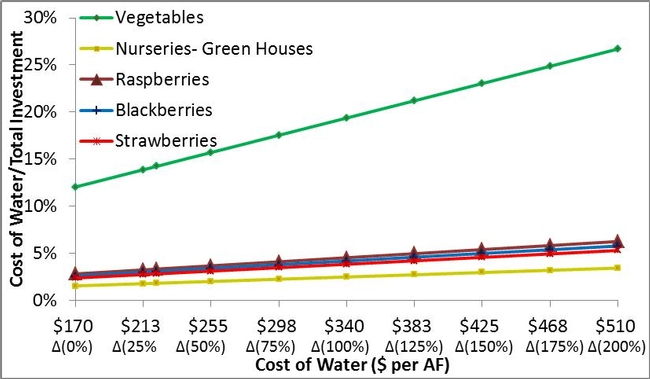Posts Tagged: economic impact
Optimizing irrigation may ease groundwater overdraft in Pajaro Valley
In the Pajaro Valley, an agricultural region in Monterey County, residents are being proactive about water conservation policies and seeking ways to save water.
Groundwater makes up roughly 90 percent of the water delivered by Pajaro Valley’s Water Management Agency (PVWMA). There is a current overdraft of groundwater in the aquifers of this region, which calls for immediate action to protect their water source. Historically, the amount of groundwater in the aquifer was above sea level so the amount of salt water in the freshwater aquifer was kept at bay. Removing too much water from the ground at a faster rate than it is being replenished has caused seawater from the Pacific Ocean to enter the aquifer as the water level tries to even out. This seawater intrusion impairs water quality because saltwater is too saline for both agriculture and human consumption.
PVWMA is implementing seven different projects to control this seawater intrusion. One of these projects is their agricultural conservation program.
Agricultural conservation program
PVWMA asked Samuel Sandoval Solis, Ph.D., UC Cooperative Extension specialist in the Department of Land, Air and Water Resources at UC Davis, to help them with their agricultural conservation program. PVWMA wanted to know the volume water that could be potentially saved and the resulting economic impact of water savings on the valley.
The key to agricultural water savings is to water a crop to its evapotranspiration (ET) value. The ET value indicates optimum water amounts that should be applied in order for the water to be completely beneficial to the plants. To estimate the potential water savings, Sandoval and his UC Davis team – undergraduate student Vicki Lin and Ph.D. students Jenna Rodriguez and Belize Lane – had to determine how many growers were surpassing a crop’s ET value. The scientists interviewed growers to find out the volume of water each grower applied to the crops and the amount of money they invested in crop production. A statistical analysis was completed with applied water data of growers from PVWMA, information from the growers’ interviews, and expert-provided ET values to check for accuracy.
The scientists also analyzed land-use data sets from 2009 and 2011 for this project. The analysis focused on 2009 because it was a normal year in terms of groundwater extraction. They determined that Pajaro Valley can save between 4,600 and 5,100 acre feet per year through conservation. This agricultural water savings program is anticipated to contribute to 41 percent of the region’s total water savings just by using water more efficiently.
Vegetable growers would take hard hit
This increase in water savings results in a direct decrease in revenue for PVWMA ranging from $842,000 to $929,000. To compensate for this loss in revenue, a potential increase in water extraction fee rates was analyzed. An increase in water fees will affect farmers, especially vegetable crop growers in the coastal region of Pajaro Valley because they already put 60 percent of their total net profits into their investment cost. These coastal vegetable growers currently receive estimated revenue of $3,910 per growing season. If their water rates are increased by 50 percent, or $103/AF, their revenue will be decreased 6.7 percent ($265) per growing season. The economic impact graph at right shows how an increase in rates will affect farmers, substantially lowering their net profit on crops. Growers of strawberries, raspberries, blackberries and nurseries have a larger return on their investments, so an increase in water fees will not affect them as dramatically.
The full 37-page report on this project can be downloaded from a link at the top of http://watermanagement.ucdavis.edu/cooperative-extension/water-savings-agriculture.
Feeling the economic pain of drought
Reduced water allowances for farmers could mean layoffs and other economic impacts, says an article in the Wall Street Journal by Jim Carlton.
The article reported that some farmers have been told to expect just 30 percent of their allotments. In response to water cutbacks, many farmers must reduce planting and leave some fields fallow.
The article referenced a UC Davis study, co-authored by Richard Howitt, of 2009 water cutbacks that resulted in "285,000 acres going fallow and the loss of 9,800 agricultural jobs, for a $340 million loss in farm-related revenues."
Pistachio Association uses UC data to calculate the crop's economic impact
The economic impact of the pistachio industry in California, Arizona and New Mexico amounts to $1.9 million for each day of the year, $682.5 million annually, according to a report commissioned by the Western Pistachio Association. The greatest economic impact is in California, where the majority of pistachios are grown.
Consultant Dennis H. Tootelian arrived at these figures using data from the Census of Agriculture, USDA, CDFA, and the University of California Cooperative Extension's Sample Costs to Establish and Produce Pistachios, according to a news release WPA distributed today via PR Newswire.
"The goal of the study was to demonstrate the overall impact of the pistachio growers' spending and their ability to generate business activity, employment, personal income and tax revenue for other industries and the states they operate in overall," Tootelian was quoted in the release.
The $682.5 million economic impact takes into account the "ripple effect" of pistachio business activity. For example:
- Pistachio growers spend nearly $415.3 million each year to produce the pistachio crop
- This spending spurs creation of 5,910 full-time equivalent jobs each year
- The employment generates more than $224.4 million each year in wages and salaries for new employees, and expanded incomes for existing industry jobs
- More than $24.4 million annually in tax revenue and other business licenses and fees are generated
"This report shows us how we as an industry contribute to the economy – through substantial job creation, funding for community programs, literally millions in tax revenues to the states where growers operate – all by simply growing the best possible product for consumers," said WPA executive director Richard Matoian.
The complete economic impact report may be viewed on the Western Pistachio Association's website.

UCCE's pistachio cost study.






